

Acoustic Two Ports - Provided by Paul Darlington. These methods take their name from techniques for the analysis of electrical networks having two pairs of wires - or ports - which can be connected to external sources, loads, etc..
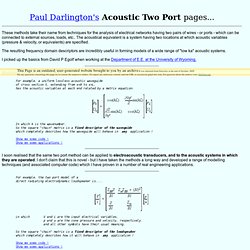
The acoustical equivalent is a system having two locations at which acoustic variables (pressure & velocity, or equivalents) are specified. The resulting frequency domain descriptors are incredibly useful in forming models of a wide range of "low ka" acoustic systems. I picked up the basics from David P Egolf when working at the Department of E.E. at the University of Wyoming. Modelling Acoustic Waveguides For example, a uniform lossless acoustic waveguide of cross section S, extending from x=0 to x=L, has the acoustic variables at each end related by a matrix equation: In which k is the wavenumber. I soon realised that the same two port method can be applied to electroacoustic transducers, and to the acoustic systems in which they are operated.
Sound Transduction. Standing Wave Ratio. This animation is almost the same as the one above, except that the red left-going wave is now upside down. Beginners' Guide to Electronics, Part 1 - Basic Components Explained. Copyright © 2001 Rod Elliott (ESP) Last Update 17 Mar 2001Basic Passive Components Articles Index Main Index Contents - Part 1 1.0 Introduction to Part 1 Having looked at some of the alternative offerings on the web, I decided it was time to do a series on basic electronics.
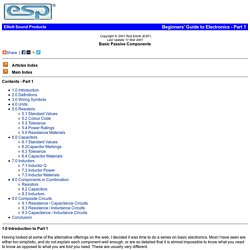
Basic components are not always as simple as they may appear at first look. This is by no means an exhaustive list, and I shall attempt to keep a reasonable balance between full explanations and simplicity. It must be noted that the US still retains some very antiquated terminology, and this often causes great confusion for the beginner (and sometimes the not-so-beginner as well). Within The Audio Pages, I use predominantly European symbols and terminology - these are also the recommended (but not mandatory) symbols and terms for Australia, and I have been using them for so long that I won't be changing them. 2.0 Definitions The basic electrical units and definitions are as shown below. Some Wiring Symbols 4.0 Units . Sound pressure level 413 particle velocity characteristic specific acoustic impedance Z sound intensity acoustics sound units intensity acoustic characteristic impedance dB SPL calculations pascal audio calculations sound units audio engineering sound rec.
The Physical Principles of Sound. An introductory guide to the physical properties of sound and a basic introduction to the acoustics of enclosed spaces.
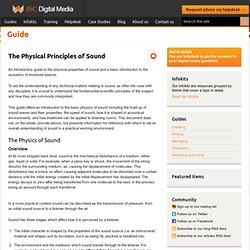
To aid the understanding of any technical matters relating to sound, as often the case with any discipline, it is crucial to understand the fundamental scientific principles of the subject and how they are commonly interpreted. This guide offers an introduction to the basic physics of sound including the build up of sound waves and their properties, the speed of sound, how it is shaped in acoustical environments, and how treatment can be applied to listening rooms. This document does not, on the whole, provide advice, but presents information for reference with which to aid an overall understanding of sound in a practical working environment. Measuring sounds in Three Dimensions. To explain how we can locate sound sources fixed in space from any observing location, we must diverge a little and consider how sound waves from live sources actually behave.
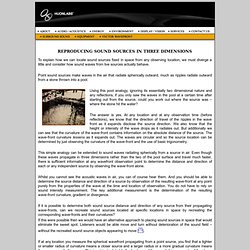
Point sound sources make waves in the air that radiate spherically outward, much as ripples radiate outward from a stone thrown into a pool. The Physical Principles of Sound. Acoustic compliance, inertance and impedance: From Physclips Waves and Sound. The specific acoustic impedance z is the ratio of sound pressure to particle velocity, and z = ρv , where ρ is the density and v the speed of sound.

(See Acoustic impedance, intensity and power to revise). So for our duct with cross sectional area A, provided that the wave is strictly one dimensional and travelling in one direction, the acoustic volume flow is just U = Au . For this very special case, we define the characteristic acoustic impedance Z0, where Z0 = p/U = p/Au = z/A so Z0 = ρv/A Of course, there usually are reflections from the other end of the pipe, whether open or closed. It is possible to have no reflections, however. Acoustic inertance Acoustic inertance and acoustic compliance introduce two very important special cases. Introduction to Sound Recording. Radiation from monopoles, dipoles, quadrupoles. If two opposite phase dipoles lie along the same line they make up a Linear Quadrupole source.
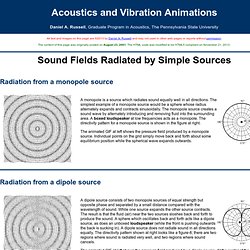
A tuning fork is a good example of a linear quadrupole source (each tine acts as a dipole as it vibrates back and forth, and the two tines oscillate in opposite directions). What makes the linear quadrupole interesting is that there is a very obvious transition from near field to far field. In the near field there are four maxima and four minima, with the maxima along the quadrupole axis about 5dB louder than the maxima perpendicular to the quadrupole axis. The near field directivity pattern is shown at right.